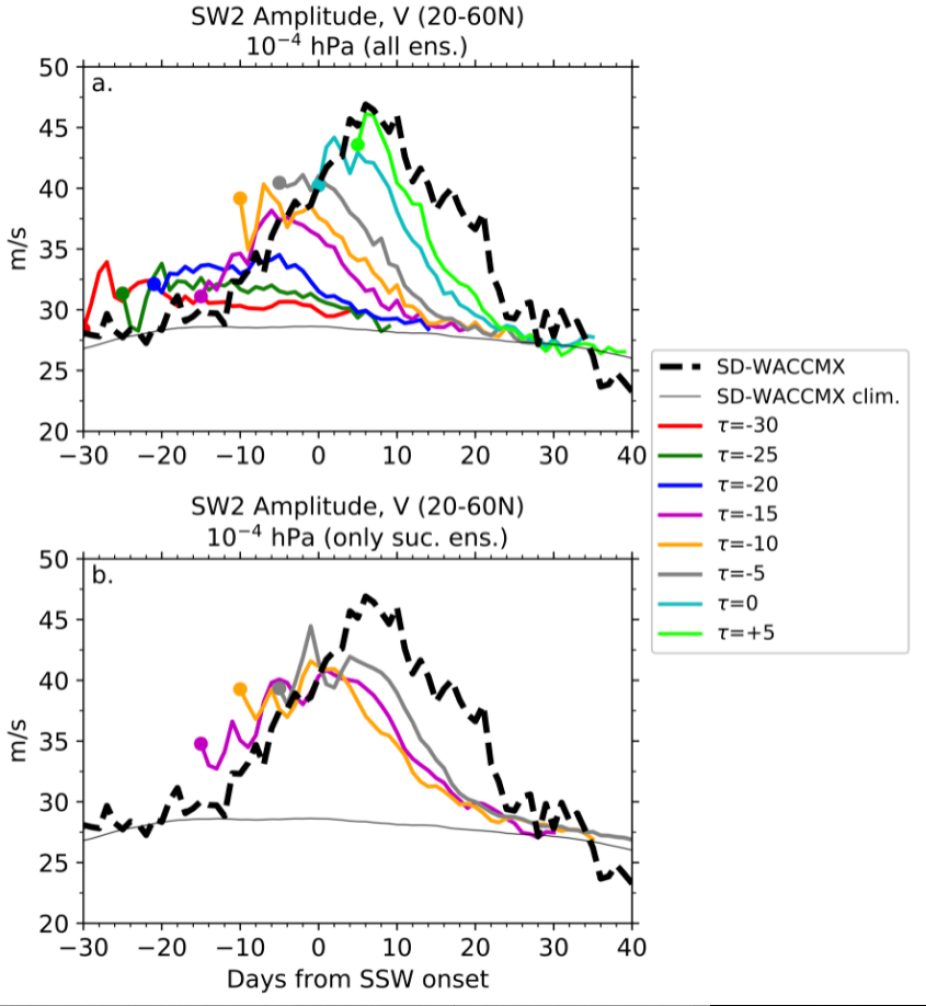Publication: Geophysical Research Letters; HAO Author: Nick Pedatella; Authors as listed: N. M. Pedatella, J. H. Richter, J. Edwards, and A. A. Glanville
Stratosphere sudden warmings (SSWs) are strong disturbances in the high latitude, wintertime, stratospheric polar vortex. The effects of SSWs are, however, not limited to the stratosphere, and SSWs influence the whole atmosphere, including tropospheric weather, chemistry and dynamics of the middle atmosphere, and the near-Earth space environment. Previous studies have demonstrated that SSWs, and their tropospheric impacts, can be forecast on multi-week timescales. Less is known about the predictability of the middle and upper atmospheres during SSWs.

SW2 amplitude in meridional wind averaged between 20-60◦N at 10−4 hPa for the composite of 14 major SSWs in SD-WACCMX (dashed black) and CESM2(WACCM6) hindcasts for (a) all ensemble members, and (b) only those ensemble members that forecast a SSW within ±7 days of the SSW onset. Results are shown for hindcasts initialized with lags of -30 (red), -25 (dark green), -20 (blue), -15 (magenta), -10 (orange), -5 (grey), 0 (cyan), and +5 (light green) days relative to the SSW onset. The thin black line indicates the SD-WACCMX 1980-2014 climatology. Amplitudes of SW2 in CESM2(WACCM6) are offset by 10m/s to account for differences in tidal amplitudes between SD-WACCMX and CESM2(WACCM6). averaged between 20-60◦N at 10−4 hPa for the composite of 14 major SSWs in SD-WACCMX (dashed black) and CESM2(WACCM6) hindcasts for (a) all ensemble members, and (b) only those ensemble members that forecast a SSW within ±7 days of the SSW onset. Results are shown for hindcasts initialized with lags of -30 (red), -25 (dark green), -20 (blue), -15 (magenta), -10 (orange), -5 (grey), 0 (cyan), and +5 (light green) days relative to the SSW onset. The thin black line indicates the SD-WACCMX 1980-2014 climatology. Amplitudes of SW2 in CESM2(WACCM6) are offset by 10m/s to account for differences in tidal amplitudes between SD-WACCMX and CESM2(WACCM6).
The present study uses subseasonal-to-seasonal hindcasts in the Community Earth System Model, version 2 with the Whole Atmosphere Community Climate Model as it's atmospheric component (CESM2(WACCM)) to investigate the predictability of the mesosphere and lower thermosphere (MLT, ~50-120 km) during SSWs. The CESM2(WACCM) hindcasts encompass 1999-2020, a period that includes 14 SSWs, enabling the first comprehensive, multi-event, investigation of the MLT predictability during SSWs. It is found that the mesosphere cooling and tidal variability during SSWs are well forecast. The demonstrated ability to predict MLT variability during SSWs indicates the potential for improved multi-day space weather forecasting through the use of whole atmosphere models that can predict the MLT variability that drives ionosphere-thermosphere variability during SSWs.